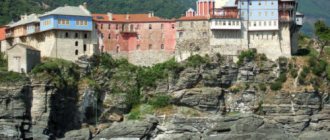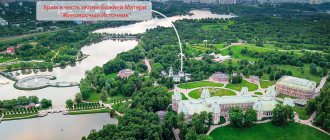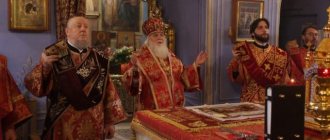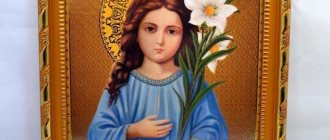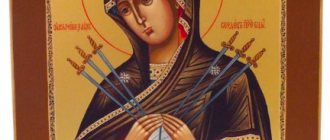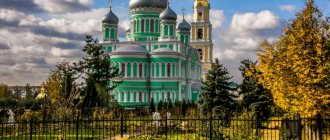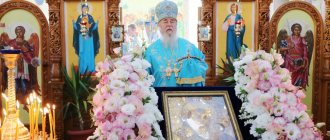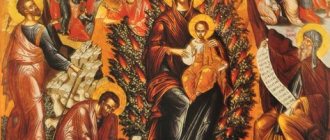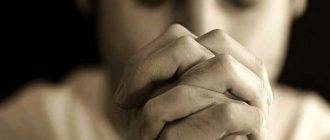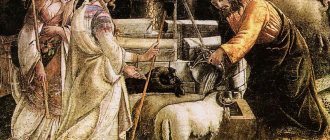| Icon of the Mother of God “Life-Giving Spring” (mosaic). Greece, Verria, Assumption Monastery (Kali-Panagia, Panagia Dovra) |
“Life-Giving Source”
(Greek: Ζωοδόχος Πηγή), icon of the Mother of God Celebration on April 4 (OCA [1]) and on Friday of Bright Week
In the century in Constantinople, near the so-called Golden Gate, there was a grove dedicated to the Blessed Virgin Mary. There was a spring in the grove, glorified for miracles for a long time. Gradually, this place was overgrown with bushes, and the water was covered with mud.
One day the warrior Leo Makella, the future emperor, met in this place a blind man, a helpless traveler who had lost his way. The lion helped him out onto the path and sit down in the shade to rest, while he himself went in search of water to give the blind man something to drink. Suddenly he heard a voice: “Lion! Don’t look far for water, it’s close here.”
.
Surprised by the mysterious voice, he began to look for water, but did not find it. When he stopped in sadness and thoughtfulness, the same voice was heard a second time: “King Lion!
Go under the shade of this grove, draw the water that you find there, and give it to the thirsty person, and put the mud that you find in the source on his eyes. Then you will know who I am, who sanctifies this place. I will help you soon build a temple here in My name, and everyone who comes here with faith and calls on My name will receive the fulfillment of their prayers and complete healing from ailments . When Leo did everything he was told, the blind man immediately received his sight and, without a guide, went to Constantinople, glorifying the Mother of God. This miracle happened under Emperor Marcian (391 - 457).
Marcian was succeeded by Leo Maccellus (457 - 473). He remembered the appearance and prediction of the Mother of God, ordered the source to be cleaned and enclosed in a stone circle, over which a temple was built in honor of the Most Holy Theotokos. Emperor Leo called this spring the “Life-Giving Spring,” since the miraculous grace of the Mother of God was manifested in it.
| Icon "Life-Giving Spring". Balykly. Monastery of the Icon of the Mother of God “Life-Giving Spring”. |
The blessed emperor Justinian the Great (527 - 565) suffered from water sickness for a long time. One day at midnight he heard a voice: “You cannot regain your health unless you drink from My source
.
The king did not know what source the voice was talking about, and became despondent. Then the Mother of God appeared to him in the afternoon and said: “Get up, king, go to My source, drink water from it and you will be healthy as before
. The patient fulfilled the will of the Lady and soon recovered. The grateful emperor erected a new magnificent temple near the temple built by Leo, at which a populous monastery was subsequently created.
In the century, the famous temple of the “Life-Giving Spring” was destroyed by Muslims. A Turkish guard was assigned to the ruins of the temple, who did not allow anyone to approach this place. Gradually, the severity of the ban softened, and Christians built a small church there. But it was also destroyed in 1821, and the source was filled up. The Christians again cleared the ruins, opened the spring and continued to draw water from it. Subsequently, in one window, among the rubble, a sheet half-rotten from time and dampness was found with a record of ten miracles from the Life-Giving Spring that occurred from 1824 to 1829. Under Sultan Mahmud, the Orthodox received some freedom in performing divine services. They used it to build a temple over the Life-Giving Spring for the third time. In 1835, the temple was consecrated with great triumph; A hospital and almshouse were set up at the temple. Even the Mohammedans spoke with great respect about the Life-Giving Spring and about the Mother of God, Who pours out Her grace-filled power through it. “Great in women is Holy Mary” - this is how they speak about the Most Pure Virgin, and the water from the Life-Giving Spring is called “the water of Holy Mary.”
One Thessalian from his youth had a strong desire to visit the Life-Giving Spring. Finally, he managed to set off, but on the way he became seriously ill. Feeling the approach of death, the Thessalian took word from his companions that they would not bury him, but would take his body to the Life-Giving Spring, there they poured three vessels of life-giving water on it and only after that buried it. His wish was fulfilled, and life returned to the Thessalian at the Life-Giving Spring. He accepted monasticism and spent the last days of his life in piety.
The appearance of the Mother of God to Leo Makella took place on April 4, 450. On this day (there is no memory in the modern church calendar of the Russian Orthodox Church), as well as annually on Friday of Bright Week, the Orthodox Church celebrates the renovation of the Constantinople temple in honor of the Life-Giving Spring. According to the charter, on this day the rite of blessing of water is performed with an Easter religious procession.
The Most Holy Theotokos with the Infant God is depicted in the icon above a huge stone bowl standing in a reservoir. Near a reservoir filled with life-giving water, those suffering from bodily ailments, passions and mental infirmities are depicted. They all drink this life-giving water and receive healing.
The history of the acquisition of the icon “Life-Giving Spring”
The history of the Life-Giving Spring icon begins with a significant event that occurred at the dawn of Christianity, in the 5th century.
A certain legionnaire Leo Makella, nicknamed the Thracian, was resting in a grove that grew near Constantinople. Suddenly a blind traveler approached him, begging for a sip of water.
Leo knew that somewhere nearby there was a spring dedicated to the Mother of God, but no matter how hard he tried, he could not find it (the place was abandoned, overgrown with bushes). And then he heard a voice coming from nowhere, showing the way to the source and commanding not only to give the suffering person a drink, but also to put mud from the source on his eyes.
Leo could not disobey the Voice and did exactly what was specified. He strengthened his faith even more when suddenly the blind man received his sight and began to praise the Lord and the Mother of God for the miracle that had been revealed.
This happened on April 4 - history has preserved the exact date of the miracle. However, oddly enough, it is not a universal day of celebration of the icon.
No less a miracle happened to the legionnaire: a few years later he ascended the throne of Constantinople and remained in history as Emperor Leo I. The grateful monarch did not forget about divine help: he ordered the stream to be cleared and a temple of the Mother of God to be erected near it, later called the “Life-Giving Spring.” " In honor of this occasion, icons of the Mother of God with the appropriate name began to be painted.
Subsequently, many miracles happened at this sacred place. The case of Emperor Justinian is widely known. The monarch was tormented by dropsy, from which there was no cure. Once Justinian heard a voice commanding him to go to a life-giving spring near Constantinople (yes, that same one), where he would receive healing.
Justinian at first accepted this sign as nonsense and, naturally, did not go to the source. But the Mother of God did not give up trying to save the emperor, and appeared to him with a similar command already in the afternoon. Justinian went to the miraculous spring and was healed of his illness.
Justinian was very grateful to the Mother of God for getting rid of his illness. In gratitude for the healing, he ordered another temple to be erected near the miraculous spring. Subsequently, a whole monastery complex was built there.
The miraculous spring near Constantinople is credited with not only healings, but also resurrections.
One pious Thessalian heard about the sacred key, decided to look at this miracle with his own eyes and, together with other pilgrims, headed towards it. On the way he became very ill. Feeling that he was dying, the pilgrim asked his comrades to bring his body to a wonderful spring, wash him in sacred water and bury him there, in sacred ground.
Fellow believers fulfilled the request of the dying man, but could not bury him: there was no need for that. As soon as the third jug of holy water was poured onto the lifeless body, the deceased pilgrim woke up. Subsequently, he took monastic vows and spent the rest of his days in prayer.
The temple and monastery at the holy spring stood until the 15th century, when Constantinople fell under the onslaught of the Ottoman Turks. The conquerors destroyed a shrine that was alien to their faith and placed guards near the miraculous spring so that not a single pilgrim could approach it.
Over time, the vigilance of the conquerors weakened and the Christians managed to build a small church in the sacred place, which stood on this site until 1821. In 1835, during the period of easing of persecution of Orthodox Christians, a new church with an almshouse and a convent was built here.
Nowadays the temple of 1835 is part of a large monastery complex. The city has grown, and it is already within the boundaries of Istanbul (formerly Constantinople). The patriarchs of the diocese of Constantinople are buried here.
Temple of the Life-Giving Spring in Istanbul
Literature
- Λόγος διαλαμβάνων τὰ περ τῆς συστάσεως τοῦ σεβασμίου οἴκου τῆς ὑπε ραγίας Δεσποίνης ἡμῶν Θεοτόκου τῆς ἀειζώου πηγῆς / Ed. A. Pamperis. Lpz., 1802;
- De sacris aedibus deque miraculis Deipare ad Fontem // ActaSS. Nov. T. 3. P. 878-889;
- PG. 147. col. 76-77.
- Millet G. Monuments byzantins de Mistra. P., 1910. Pl. 88-105;
- Medakovi D. Mother of God “Life-Giving Source” in Srpsk relevance // ZRVI. Beograd, 1958. Књ. 5. P. 203-217;
- Antonova, Mneva. Catalog. T. 2. S. 445, 453;
- Velmans T. L'iconographie de la “Fontaine de vie” dans la tradition byzantine ŕ la fin du Moyen Âge // Synthronon: Art et archéologie de la fin de l'Antiquité et du Moyen Âge / Ed. A. Grabar. P., 1968. P. 128-134;
- Vzdornov G.I. Volotovo: Frescoes c. Dormition on Volotovo Field near Novgorod. M., 1989. Cat. 168;
- Talbot AM Epigrams of Manuel Philes on the Theotokos tes Peges and its Art // DOP. 1994. Vol. 48. P. 136-137;
- she is the same. Miracle-working images in the K-Polish temple of the “Life-Giving Source” // Miracle-working icon in Byzantium and Others. Rus' / Edited by: A. M. Lidov. M., 1996. S. 117-122;
- Kondakov. Iconography of the Mother of God. T. 2. P. 372-377;
- Sophia the Wisdom of God: Cat. vyst. M., 2000. Cat. 79. P. 230;
- Praise to the Mother of God: Icons of Yaroslavl XIII-XX centuries. from collection YAIAHMZ. Cat. vyst. / Author: O. B. Kuznetsova, A. V. Fedorchuk. M., 2003. Cat. 15. pp. 38-41;
- Khokhlova I. L. Icons of the Rybinsk Museum. M., 2005. Cat. 6. P. 32-35;
- Icons of Vladimir and Suzdal. M., 2006. Cat. 111. pp. 488-489;
- Orthodox icon of Russia, Ukraine, Belarus: Cat. vyst. M., 2008. pp. 167-168.
Iconography
This icon does not have a clearly defined iconographic type. However, its prototype goes back to the Greek Nikopeia Kyriotissa, written in the likeness of Oranta (“Signs”), where the baby Jesus is depicted in the center of the mother’s figure. However, Nikopea clutches the Divine Son to her chest, while Oranta's hands are raised in a gesture of prayer.
It is believed that the ancestor of this iconographic type is the Evangelist Luke. His brush was directed by God himself, and some evidence indicates that he personally knew Mary.
Subsequently, the image underwent significant evolution. Icon painters, starting from the 13th century, presented their vision of the “Life-Giving Source”. At first in Rus' they depicted the classical Oranta with raised arms, then her full-length figure was placed in a bowl-vial (as in the images of Ushakov).
Later, the Mother of God with Jesus began to be increasingly framed with figures of saints and angels, as well as scenes of miracles, and an image of a source appeared (usually in the form of a miniature pool, well or fountain).
Images of icons
In the icon, thanks to a special artistic project, you can see the Mother of God sitting in a huge gilded font. She holds her little son, Jesus Christ, in her arms. Just below the bowl, the same Life-Giving Spring is clearly depicted, lined with exquisite tiles around the edges.
Few people know that in the first icons of the Mother of God the Life-Giving Spring there was no reservoir or fountain gushing from a bowl. However, in later compositions this important element was added.
The meaning of the “Life-Giving Spring” icon in Orthodoxy
Water has always been considered a symbol and source of life - even adherents of Darwin’s theory do not protest against this (it is believed that life as such originated in the water element).
The symbol of water is also present in many religious stories, and it is identified with Divine power: this is the biblical Great Flood, Christ walking on water like dry land, Moses leading his people through parting waters, and so on. We do not forget about the sacrament of baptism, which takes place with the indispensable participation of water, as well as the traditional swimming in an ice hole on the holiday of the great blessing of water (Epiphany).
The icon means that the Mother of God serves as the source of Life, for Christ is Life. In addition, the Mother of God is a source of protection, grace and love, open to everyone who prays for salvation, healing, and guidance.
This image is very loved by ordinary people because it does not require complex theological interpretations. Therefore, in Russia, Belarus and Ukraine you can see many chapels consecrated in honor of the “Life-Giving Spring”. And next to it are the actual springs with life-giving water, where you can drink and sometimes even wash.
Meaning and description of the icon
Iconography classifies the image as an Oranta type, i.e. Praying. One of the ancient icons dating back to the 14th century was found in Crimea. It was during that period that a variant close to the modern image arose. The icon came to Russia from Greece.
The composition of the image is complex:
- In the icon, the Most Pure One with the Infant God is depicted above a very large stone vessel (bowl), which stands in water. In some images She appears to be floating, in others Her feet are hidden in a bowl.
- Near the reservoir, inside of which the bowl is located, there are people burdened with physical and mental illnesses. They drink the wonderful water and are healed.
- The Infant God is depicted either with outstretched arms or holding a scroll.
Icon painters use different options. Thus, master Semyon Ushakov placed 16 small icons around the main image, which told the story of the “Life-Giving Spring”. The semantic meaning of the composition lies not only in the fact that holy water benefits the soul and body. The source is an image of the Most Holy Theotokos herself, because She gave birth to the Savior of the world.
Iconography relates the image to the Orant type
Famous lists of the “Life-Giving Spring”
The oldest image of the Mother of God “Life-Giving Spring” was discovered in Crimea. The image is painted on a clay saucer. The approximate date of creation is the end of the 13th century.
A slightly later image (around the 15th century) is a fresco by Andronikos the Byzantine. On it, the Virgin Mary and her offspring are depicted in a bowl, and it is framed by an inscription, translated meaning “life-giving source.” Unfortunately, this image (which, by the way, is well preserved) is inaccessible to most pilgrims, for it is located in a monastery, on the land of St. Athos.
Of the most revered lists that exist in Rus', it is worth mentioning the images located in the Sarov desert. The first dates back to the 18th century (he was greatly revered by St. Seraphim of Sarov), the second, no less revered, is about a century younger.
Temples of the Life-Giving Spring and the icon of the same name are located in Moscow (in Tsaritsyno and Bibirevo), Arzamas, Kharkov, Athens, and, of course, in Istanbul. You can pray to the copies from the image in Urzhum, Lipetsk, Tver and other cities, as well as in chapels scattered throughout Russia.
Church of the Icon of the Mother of God “Life-Giving Spring” in Tsaritsyno
Sources
An anonymous text from the 10th century about the miracle of finding a spring and 47 cases of healing from it [5] became the basis for the work of the Byzantine church historian Nicephorus Callistus Xanthopoulos, written between 1306 and 1328 (Λόγος διαλαμβάνων...). In addition to the text of the anonymous Nicephorus, Callistus reported the cessation of miracles from the source during the years of Latin rule of Constantinople (1204-1261) and the Union of Lyons (1274), concluded by the emperor. Michael VIII Palaiologos (1259-1282), and about their renewal (15 miracles) after the accession to the throne of the Emperor. Andronikos II Palaiologos (1282-1328).
What does an icon help with?
The life-giving icon became famous for its great miracles. Her revered lists include many cases of divine healings from serious illnesses, including paralysis, blindness, infertility and even cancer.
This icon is especially popular among people suffering from chronic physical and mental illnesses. Elderly believers often come to her with a request to overcome the infirmities of old age, and mature ladies who want to maintain their blooming appearance.
In addition, the icon is asked for:
- restoring peace and harmony in the family;
- consolation after heavy losses (including the death of loved ones);
- conception and birth of healthy offspring;
- guidance on the true path (yourself, loved ones, children);
- resolving material problems.
The Mother of God is an inexhaustible source of love and mercy available to each of us. Whatever our sins, she is ready to intercede for us before the Savior. And this despite the fact that every unseemly act of ours multiplies the suffering of Christ, that is, her own son!
In the 5th century in Constantinople there was a grove of the Blessed Virgin Mary, where there was a source
In Constantinople in the 5th century there was a grove that was dedicated to the Blessed Virgin Mary. Why was the grove dedicated specifically to the Mother of God?
In this grove there was one inexhaustible spring, which was famous for its many miracles. Later, this place was overgrown with bushes, and the water was completely covered with mud.
Finding that same life-giving source would be very difficult.
One day, the warrior Leo Marcellus met a blind man near these places who suggested the way. He sat the blind man in the shade, and he himself went in search of water.
As he walked, he heard a voice: “...Lion! Don’t look far for water, it’s close here.” Surprised by such a miracle, he went to look for water, but did not find it.
After Leo Markell found the source of the Mother of God, many people began to flock to him.
Then Leo was upset, but immediately heard the voice again: “...King Lion! Go under the shade of this grove, draw the water that you find there, and give it to the thirsty person, and put the mud that you find in the source on his eyes.
Then you will know who I am, who sanctifies this place. I will help you soon build a temple here in My name, and everyone who comes here with faith and calls on My name will receive the fulfillment of their prayers and complete healing from ailments.”
Then Leo I Marcellus found a source of water, after which the blind man regained his sight, glorifying the Mother of God. This miracle happened during the reign of Emperor Marcian.
When is the day of the icon celebrated?
The celebration of the “Life-Giving Spring” icon on April 4 (in honor of the miracle that happened to the legionnaire Leo) takes place mainly in churches consecrated in honor of this bright image.
The official day of the icon is transitory, that is, depending on the date of Easter. It is usually celebrated on Friday of Holy Week (that is, the week following Easter Sunday).
On the day of the celebration of the icon, a procession of the cross takes place. The rite of small blessing of water is required (the major blessing of water occurs at Epiphany).
Prayers
Troparion, tone 4
Let us, people, gain goals for our souls and bodies through prayer, / for the river precedes everything, the Most Pure Queen Theotokos, / pouring out wonderful water for us, / and washing away the blackness of our hearts, / sinful pages purifying spirits,/ sanctifying the souls of the faithful // with Divine grace.
Troparion, Greek, tone 3
[2]
Heavy rain
[3]
Concealed,/ the living spring, the Virgin, you appeared,/ having flowed out for us the nectar of immortality,/ the water leaping into the eternal belly,/ the sweet-streaming streams/ from Thy source always./ And Nearby, enjoying ourselves, we cry: Rejoice, O life-giving Source.
Kontakion, tone 8
From the inexhaustible You, God-blessed Source,/ give me, flowing, the waters of Your grace,/ ever-flowing more than the word,/ as if the Word gave birth more than the meaning,/ I pray to You, irrigate I call you by grace, and I call you: Rejoice, water of salvation.
Kontakion Greek, tone 8
[4]
From Your inexhaustible Source, O God-gracious One, / give to me, sharpening the inexhaustible streams of Your grace, more than the Word. / As one who gave birth more than thoughts, I pray to You: / Irrigate me with Yours by grace, let me call you: rejoice, saving water
.
How to pray in front of an icon
The image of the “Life-Giving Spring” can be hung separately in the house or included in the family altar. This icon is usually placed on the same level as the image of the Savior, to the right of it. If desired, you can place the image on a table, shelf or above the bed in any of the living rooms. Or you can always carry the holy image with you - on a pendant or bracelet.
It is extremely undesirable for the icon of the Mother of God to be adjacent to some worldly objects: paintings, figurines, secular books, a TV or a stereo system.
Before prayer, it is advisable to light a candle or lamp and read the “Our Father” thoughtfully and seriously. When praying to the Mother of God, you should not escalate the drama and sob theatrically and tear out your hair: just read the text with concentration. And after the canonical prayer (if desired, and instead of it), you can turn to the Mother of God in your own words.
Prayer text
Oh, Most Holy Virgin, Mother of our Lord Jesus Christ! You are the Mother and patroness of all who come running to You, look with compassion on the prayers of Your sinners and humble children. You, called the Life-Giving Source of grace-filled healings, heal the illnesses of the afflicted and pray to Your Son, our Lord Jesus Christ, to bestow health of soul and body on all who flow to You. dear and, having forgiven us our voluntary and involuntary sins, gives us everything that is eternal and temporal necessary for life. You are the joy of all who mourn, hear us, the sorrowful; You are the quencher of sorrow, quench our sorrow too; You are the seeker of the lost, do not allow us to perish in the abyss of our sins, but always deliver us from all sorrows and misfortunes and all evil circumstances. To her, our most blessed Queen, our indestructible hope and invincible intercessor, do not turn Your face away from us for the many of our sins, but extend to us the hand of Your Motherly mercy And do with us a sign of Thy mercy for good: show us Thy help and prosper in every matter good. Turn us away from every sinful undertaking and evil thought, so that we may always glorify Your most honorable name, magnifying God the Father and the Son of the Only Begotten Lord Jesus Christ and the Life-Giving Holy One God's Spirit with all the saints forever and ever. Amen.
The all-good and all-merciful Queen of Heaven will hear even the simplest prayer uttered in her own words. However, one must not only ask for God’s mercy, but also remember to thank the Mother of God for her help. And the prayer of thanksgiving is best supported by good deeds and strengthening of faith.
18.10.21
Miraculous help of the Mother of God
To this day, the Blessed Virgin continues to work miracles. Their descriptions are kept in the church books of temples and monasteries.
- in front of the “Life-Giving Spring” icon, it is recommended to offer prayers to people suffering from serious and even incurable diseases;
- Mother helps women conceive, bear and give birth to a long-awaited child;
- Those people who are suffering from mental anguish should pray before the Face of the Mother of God;
- The Queen of Heaven helps people overcome the habit of smoking and overcome alcoholism;
- Mother helps raise children in the faith;
- promotes reconciliation of spouses and family reunification;
- teaches humanity, the ability to remain virtuous in any life situations.
Important! It should be remembered that as a person prays, he receives such help through his prayers. Carelessly and insincerely pronounced words of prayer are unlikely to help in the sorrows that burden the soul of the pilgrim. Repentance, a pure heart and sincere love are the key to the Virgin’s intercession.
Spring, holy source of the icon “Life-Giving Spring” of the Blessed Virgin Mary, village of Bolshaya Valyaevka
Miracles performed by this divine shrine
One Thessalian dreamed from childhood that when he grew up, he would see with his own eyes the place from which holy water flowed. And finally the moment came when he and other Orthodox Christians were able to begin their long pilgrimage journey.
But on the way, the young man became infected and when he realized that he would soon die, he asked others traveling with him not to bury him after his death, but to still carry him to his destination and pour 3 jugs of healing water on him, and only then betray his body earth.
His request was fulfilled, but when the third jug of water was poured onto the body of the righteous man, a miracle happened and he came to life. After such an amazing resurrection, the young man decided to serve God and the Mother of God until his death, prayers to whom helped him return to life again.
There are also other examples of the healing effects of spring water. But we must remember that a miracle occurs only under the condition of a fervent, sincere and sincere prayer to the Creator and if a person leads a righteous lifestyle and does not commit any sins. Only in this case can he count on receiving the expected relief and healing.
In which churches can you find the icon of the Mother of God the Life-Giving Spring?
At this point in time, there are more than a hundred chapels and churches that received their name in honor of the Mother of God. Next, I suggest you familiarize yourself with some of them:
- Temple of the Image of the Mother of God (Cosmodamian) in Metkino, Moscow region. Ancient chronicles tell that in the 17th century, not far from Moscow, there was a wooden temple of Damian and Cosmas, but in 1701 it was burned. Fortunately, most of the images were saved; they were transferred to a small chapel located nearby.
The destroyed church in 1848 was replaced by a real temple of God, which is dedicated to the miraculous face of the Mother of God. This is also not accidental, since in 1829 a miraculous appearance of the saint’s face occurred. And in 1840, Avdotya Evdokimova, the widow of a soldier, gave a miraculous icon to the village of Metkino, which was given to her by the merchant Anna Kiryanova. Since then, people from nearby areas have come to the temple to venerate the holy image.
- Another icon dedicated to the Mother of God can be found in Tsaritsyno (Moscow).
- In the city of Tver there is a cathedral with a miraculous image of the Mother of God (in the Sorrow Church).
- There is also a Church of the Healing Icon of the Holy Virgin Mary in the Nativity of the Virgin Mary Monastery (Zadonsk).
- In addition, you will find a healing icon in the Church of the Mother of God (city of Arzamas).
Now you know the full characteristics of the “Life-Giving Source” image. Finally, I would like to note only that the most important condition for receiving divine help is sincere faith in this help.
Therefore, believe in miracles and finish reading the article by watching a fascinating thematic video:
